八年级上册比较级和最高级
- 格式:ppt
- 大小:424.50 KB
- 文档页数:2
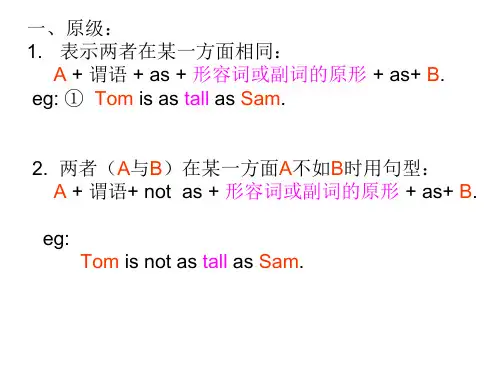
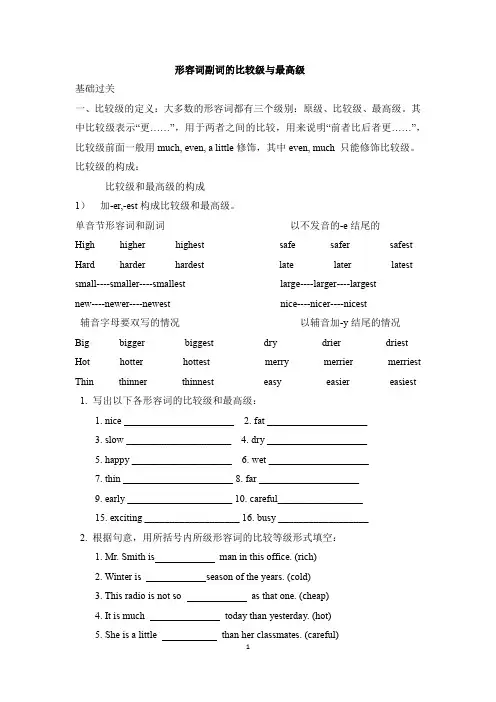
形容词副词的比较级与最高级基础过关一、比较级的定义:大多数的形容词都有三个级别:原级、比较级、最高级。
其中比较级表示“更……”,用于两者之间的比较,用来说明“前者比后者更……”,比较级前面一般用much, even, a little修饰,其中even, much 只能修饰比较级。
比较级的构成:比较级和最高级的构成1)加-er,-est构成比较级和最高级。
单音节形容词和副词以不发音的-e结尾的High higher highest safe safer safest Hard harder hardest late later latest small----smaller----smallest large----larger----largestnew----newer----newest nice----nicer----nicest辅音字母要双写的情况以辅音加-y结尾的情况Big bigger biggest dry drier driest Hot hotter hottest merry merrier merriest Thin thinner thinnest easy easier easiest 1. 写出以下各形容词的比较级和最高级:1. nice ______________________2. fat ____________________3. slow _____________________4. dry ____________________5. happy ____________________6. wet ____________________7. thin ______________________ 8. far ____________________9. early _____________________ 10. careful_________________15. exciting ___________________ 16. busy __________________2. 根据句意,用所括号内所级形容词的比较等级形式填空:1. Mr. Smith is man in this office. (rich)2. Winter is season of the years. (cold)3. This radio is not so as that one. (cheap)4. It is much today than yesterday. (hot)5. She is a little than her classmates. (careful)6. people came to the meeting than last time. (many)7. Which book is , this one or that one? (easy)8. My room is than yours. (small)9. Hainan is from Beijing than Hunan. (far)10. Skating is than swimming. (exciting)11. Jim is than all the others. (honest)12. The higher you climb, the it will be. (cold)13.There are boys than girls in our class. (few)2) 加more, most构成比较级和最高级多音节的形容词由形容词加-ly构成的副词expensive more expensive most expensive slowly more slowly most slowly carefully more carefully most carefully highly more highly most highly 以-ful,-less,-able,-ous,-ive, -ing等结尾的双元音形容词useless more useless most uselessserious more serious most serious分词形容词tired,pleased及glad,often,real, right,wrong等单音节形容词。
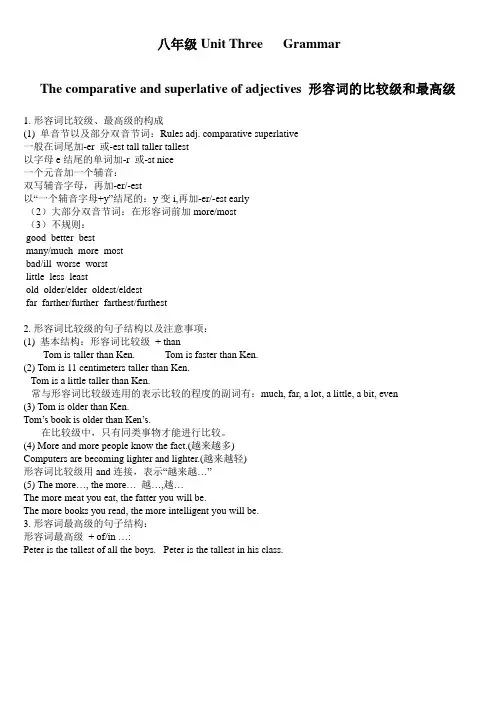
The comparative and superlative of adjectives 形容词的比较级和最高级1. 形容词比较级、最高级的构成(1) 单音节以及部分双音节词:Rules adj. comparative superlative一般在词尾加-er 或-est tall taller tallest以字母e结尾的单词加-r 或-st nice一个元音加一个辅音:双写辅音字母,再加-er/-est以“一个辅音字母+y”结尾的:y变i,再加-er/-est early(2)大部分双音节词:在形容词前加more/most(3)不规则:good better bestmany/much more mostbad/ill worse worstlittle less leastold older/elder oldest/eldestfar farther/further farthest/furthest2. 形容词比较级的句子结构以及注意事项:(1) 基本结构:形容词比较级+ thanTom is taller than Ken. Tom is faster than Ken.(2) Tom is 11 centimeters taller than Ken.Tom is a little taller than Ken.常与形容词比较级连用的表示比较的程度的副词有:much, far, a lot, a little, a bit, even(3) Tom is older than Ken.Tom’s book is older than Ken’s.在比较级中,只有同类事物才能进行比较。
(4) More and more people know the fact.(越来越多)Computers are becoming lighter and lighter.(越来越轻)形容词比较级用and连接,表示“越来越…”(5) The more…, the more… 越…,越…The more meat you eat, the fatter you will be.The more books you read, the more intelligent you will be.3. 形容词最高级的句子结构:形容词最高级+ of/in …:Peter is the tallest of all the boys. Peter is the tallest in his class.形容词比较级练习一、写出下列形容词的比较级和最高级。

八年级上册英语比较级和最高级一、比较级和最高级的定义。
1. 比较级。
- 比较级用于两者之间的比较,表示“更……”的意思。
例如:This book is more interesting than that one.(这本书比那本书更有趣。
)2. 最高级。
- 最高级用于三者或三者以上的比较,表示“最……”的意思。
例如:He is the tallest boy in our class.(他是我们班最高的男孩。
)二、比较级和最高级的构成规则(规则变化)1. 单音节形容词和部分双音节形容词。
- 比较级:- 一般在词尾加 -er。
例如:tall - taller,small - smaller。
- 以e结尾的形容词,直接加 -r。
例如:nice - nicer,large - larger。
- 以重读闭音节结尾,且末尾只有一个辅音字母的形容词,先双写这个辅音字母,再加 -er。
例如:big - bigger,hot - hotter。
- 最高级:- 一般在词尾加 -est。
例如:tall - tallest,small - smallest。
- 以e结尾的形容词,直接加 -st。
例如:nice - nicest,large - largest。
- 以重读闭音节结尾,且末尾只有一个辅音字母的形容词,先双写这个辅音字母,再加 -est。
例如:big - biggest,hot - hottest。
2. 多音节形容词和部分双音节形容词。
- 比较级:在形容词前面加more。
例如:beautiful - more beautiful,interesting - more interesting。
- 最高级:在形容词前面加most。
例如:beautiful - most beautiful,interesting - most interesting。
三、不规则变化的形容词比较级和最高级。
1. good/well - better - best(好的)2. bad/badly - worse - worst(坏的;糟糕地)3. many/much - more - most(许多)4. little - less - least(少的)5. far - farther/further - farthest/furthest(远的;进一步的)四、比较级和最高级的用法。
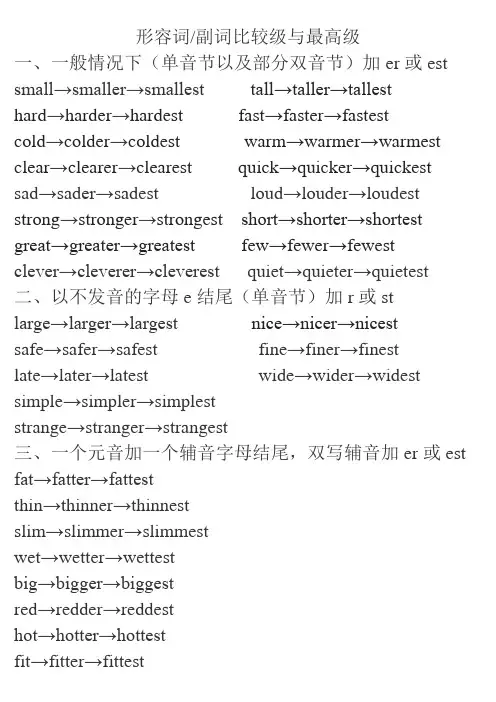

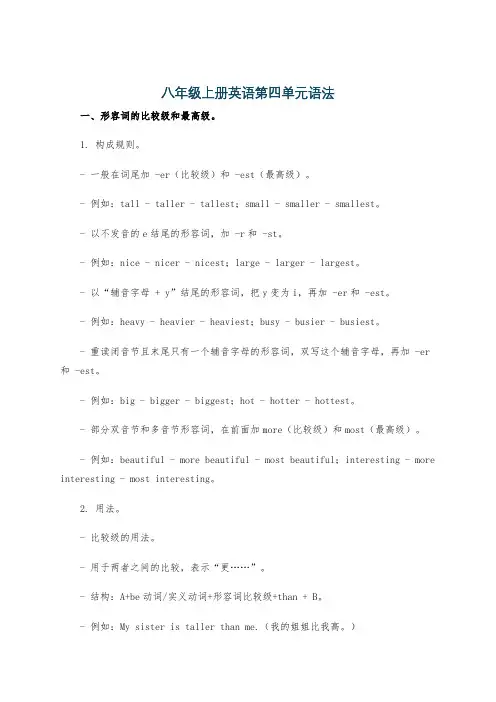
八年级上册英语第四单元语法一、形容词的比较级和最高级。
1. 构成规则。
- 一般在词尾加 -er(比较级)和 -est(最高级)。
- 例如:tall - taller - tallest;small - smaller - smallest。
- 以不发音的e结尾的形容词,加 -r和 -st。
- 例如:nice - nicer - nicest;large - larger - largest。
- 以“辅音字母 + y”结尾的形容词,把y变为i,再加 -er和 -est。
- 例如:heavy - heavier - heaviest;busy - busier - busiest。
- 重读闭音节且末尾只有一个辅音字母的形容词,双写这个辅音字母,再加 -er 和 -est。
- 例如:big - bigger - biggest;hot - hotter - hottest。
- 部分双音节和多音节形容词,在前面加more(比较级)和most(最高级)。
- 例如:beautiful - more beautiful - most beautiful;interesting - more interesting - most interesting。
2. 用法。
- 比较级的用法。
- 用于两者之间的比较,表示“更……”。
- 结构:A+be动词/实义动词+形容词比较级+than + B。
- 例如:My sister is taller than me.(我的姐姐比我高。
)- He runs faster than his brother.(他跑得比他哥哥快。
)- 比较级前可以用much, a little, a bit, even等词来修饰,表示程度。
- 例如:This book is much more interesting than that one.(这本书比那本有趣得多。
)- She is a little shorter than her friend.(她比她的朋友矮一点。
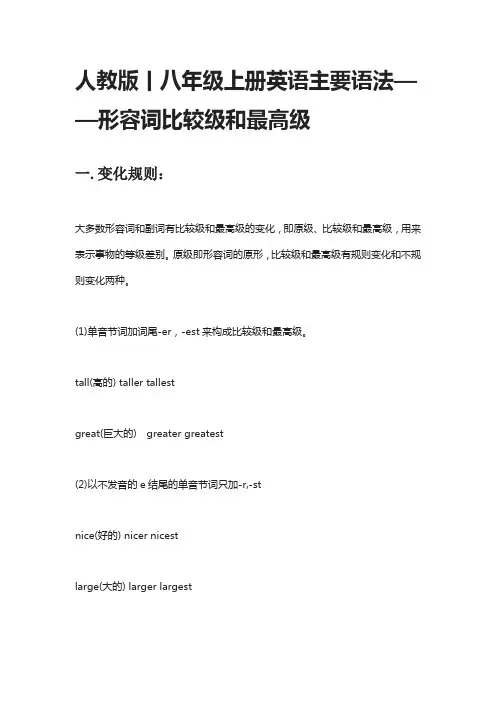
人教版丨八年级上册英语主要语法——形容词比较级和最高级一.变化规则:大多数形容词和副词有比较级和最高级的变化,即原级、比较级和最高级,用来表示事物的等级差别。
原级即形容词的原形,比较级和最高级有规则变化和不规则变化两种。
(1)单音节词加词尾-er,-est来构成比较级和最高级。
tall(高的) taller tallestgreat(巨大的) greater greatest(2)以不发音的e结尾的单音节词只加-r,-stnice(好的) nicer nicestlarge(大的) larger largestable(有能力的) abler ablest(3)以一个辅音字母结尾的闭音节单音节词,双写结尾的辅音字母,再加-er,-est big(大的) bigger biggesthot热的) hotter hottestred红色的redder reddest(4)"以辅音字母+y"结尾的双音节词,改y为i,再加-er,-esteasy(容易的) easier easiestbusy(忙的) busier busiest(5)以ly结尾的副词,除early-earlier-earliest,其他都是加more most. Slowly-more slowly-most slowlyBravely-more bravely-most bravelyquickly-more quickly-most quickly(6)少数以-er,-ow结尾的双音节词未尾加-er,-estclever(聪明的) cleverer cleverestnarrow(窄的) narrower narrowest(7)其他双音节词和多音节词在前面加more,most来构成比较级和最高级。
如:important(重要的) more important most importanteasily(容易地) more easily most easily(8)一些词的比较级和最高级,可以加-er或-est,也可以加more或most,如:clever, polite等。
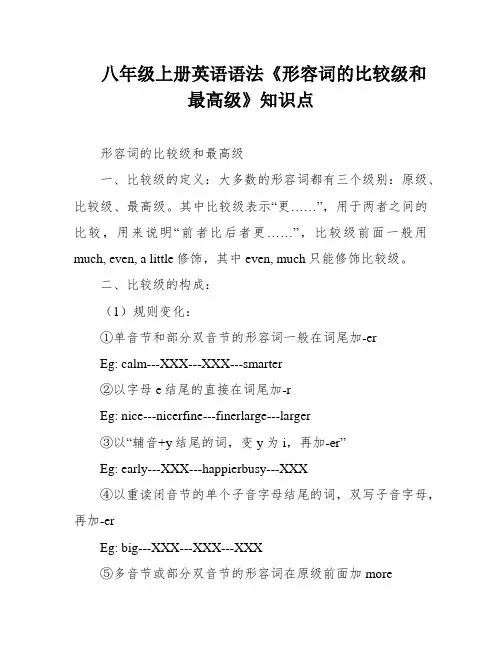
八年级上册英语语法《形容词的比较级和最高级》知识点形容词的比较级和最高级一、比较级的定义:大多数的形容词都有三个级别:原级、比较级、最高级。
其中比较级表示“更……”,用于两者之间的比较,用来说明“前者比后者更……”,比较级前面一般用much, even, a little修饰,其中even, much只能修饰比较级。
二、比较级的构成:(1)规则变化:①单音节和部分双音节的形容词一般在词尾加-erEg: calm---XXX---XXX---smarter②以字母e结尾的直接在词尾加-rEg: nice---nicerfine---finerlarge---larger③以“辅音+y结尾的词,变y为i,再加-er”Eg: early---XXX---happierbusy---XXX④以重读闭音节的单个子音字母结尾的词,双写子音字母,再加-erEg: big---XXX---XXX---XXX⑤多音节或部分双音节的形容词在原级前面加moreEg: popular---more popularimportant---more important(2)不划定规矩变革:少数形容词的比较级变化是不规则的:good---XXX/ill---worsemany/much---morelittle---lessfar---XXX---older/elder三、比力级的用法:(一)当两小我或事物(A和B)举行比力时,我们需要用到描述词(副词)的原级或者比力级1.表达“A和B一样”,用as…as的结构。
公式: A+be动词+as+描述词原级+as…+BA+实义动词+as+副词原级+as…+BEg:I am as tall as you.我和你一样高。
He runs as fast as I.他跑得和我一样快。
2.表达“A不如B”用not as…as的结构。
公式: A+be动词的否定形式+as+形容词原级+as…+BA+助词的否定形式+动词+as+形容词原级+as…+BEg:I am not as tall as you.我没有你高。
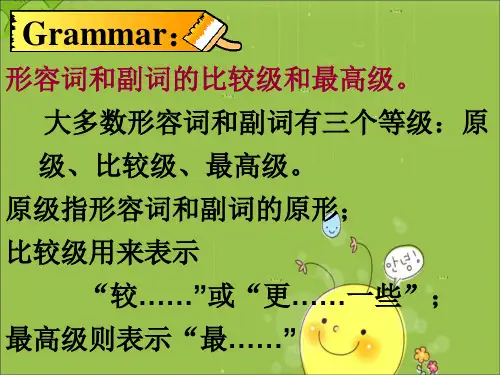
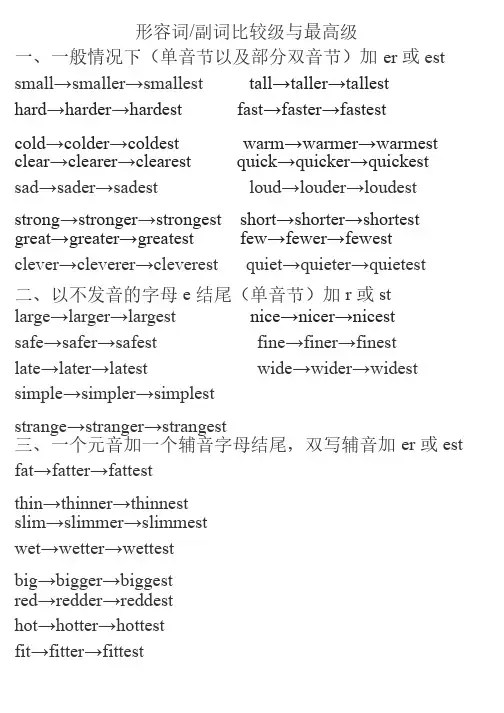
形容词/副词比较级与最高级一、一般情况下(单音节以及部分双音节)加er或est small→smaller→smallest tall→taller→tallesthard→harder→hardest fast→faster→fastest cold→colder→coldest warm→warmer→warmest clear→clearer→clearest quick→quicker→quickest sad→sad er→sadest loud→louder→loudest strong→stronger→strongest short→shorter→shortest great→greater→greatest few→fewer→fewest clever→cleverer→cleverest quiet→quieter→quietest 二、以不发音的字母e结尾(单音节)加r或st large→larger→largest nice→nicer→nicestsafe→safer→safest fine→finer→finest late→later→latest wide→wider→widest simple→simpler→simplest strange→stranger→strangest 三、一个元音加一个辅音字母结尾,双写辅音加er或est fat→fatter→fattest thin→thinner→thinnest slim→slimmer→slimmest wet→wetter→wettest big→bigger→biggest red→redder→reddest hot→hotter→hottestfit→fitter→fittest 四、辅音字母加y结尾,变y为i加er或est easy→easier→easiest angry→angrier→angriest busy→busier→busiest heavy→heavier→heaviest hungry→hungrier→hungriest crazy→crazier→craziest happy→happier→happiest early→earlier→earliest dirty→dirtier→dirtiest lucky→luckier→luckiestshy→shier→shiest funny→funnier→funniest lovely→lovelier→loveliest friendly→friendlier→friendliest 五、双音节以及多音节词前加more或most outgoing→more outgoing→most outgoing beautiful→more beautiful→most beautifuldifferent→more different→most differentquietly→more quietly→most quietly loudly→more loudly→most loudly slowly→more slowly→mo st slowly quickly→more quickly→mo st quickly sadly→more sadly→mo st sadly happily→more happily→mo st happily carefully→more carefully→mo st carefully serious→more serious→most serious →mo st similar similar→more similar→moeasily easily→more easily→most e asily clearly→more clearly→mo st clearly bored→more bored→mo st bored talented→more talented→mo st talented boring→more boring→mo st boring →mo st popular popular→more popular→moterrible→more terrible→mo st terrible delicious→more delicious→mo st delicious →mo st different different→more different→mo→mo st difficult difficult→more difficult→mo→mo st beautiful beautiful→more beautiful→moexpensive→more expensive→mo st expensive necessary→more necessary→mo st necessary →mo st important important→more important→mo→mo st wonderful wonderful→more wonderful→mocomfortable→more comfortable→mo st comfortable hardworking→more hardworking→mo st hardworking 不规则adj、adv比较级、最高级good/well→better→best bad/badly/ill→worse→worst many/much→more→most few/little→less→least old→older/elder→oldest/eldest far→farther/further→farthest/furthest 无比较级的adj/adv fantastic excellent favorite true(ly) false right wrong full empty round square possible impossible 。
八年级上册Unit 3 单元语法一、温故而知新1.写出下列短语:想某人挑战:承诺某人做某事:命令某人做某事:听从某人的意见:用…的方法:2. the amount of / the number of的区别:3. instead 的考点:固定搭配:instead 和instead of的区别:4. enough的用法:(2个)二、新授形容词的比较级和最高级(1)比较级和最高级的构成规则变化看形容词长短。
一个音节的在词尾加-er, 三个音节以上的用more, 两个音节的两者方法均可。
单音节和双音节●总结:直接在形容词后加—er或者—est单音节和部分双音节的构成方法:多音节●总结:在形容词前加more/ most,形容词样子不变多音节形容词的比较级在其前加more构成:important →more important→ most importantbeautiful → more beautiful→most beautiful不规则变化实战演练:(1)写出下列形容词和副词的比较级和最高级young nicegood earlymuch deliciousshort littlebeautiful fatwell bad(2) 用所给形容词副词的适当形式填空1. Tom is (tall) than Jim.2. Li Lei is (young) boy in his class.3. I think English is (interesting) than any other subject.4. David has (many)story books of all the students.5. Li Lei speaks English (well) in his group.6. Lucy runs (slow) than Lily.7. Ann is (old) than Hans.8. Summer is the (warm) of the four seasons.9. These cars are the (expensive) in China.3、形容词比较级和最高级的用法比较级的用法:最高级的用法:①比较级+ than ①the+ 最高级②两者进行比较②三者以上比较③much /even /a little/a lot +比较级实战演练:在横线上填上形容词的适当形式1. He is much _______ (good) at Chinese and he is the _________ (bad) at English.2. The Chang Jiang River is the _______ (long) river in China.3. Which is _________ (heavy), a hen or a chicken?4.She is even (short) than Sally. She is also the _______ (short) girl in the class.5. A dictionary is much _________________ (expensive) than a story-book三、习题演练(1)用所给词的适当形式填空。
八年级上册语法专题--形容词比较级和最高级一、知识梳理形容词的比较级和最高级的变化分为有规则变化和不规则变化。
1 规则变化:类别构成方法原级比较级最高级单音节词和少数双音节词一般直接加-er,-estlongtalllongertallerlongesttallest 以不发音的e 结尾时加-r,-stlatelargelaterlargerlatestlargest 以辅音字母加y结尾时把y变i,再加-er,-esteasyhappyeasierhappiereasiesthappiest 以重读闭音节结尾且末尾只有一个辅音字母时,双写最后的辅音字母,再加-er,-estbighotbiggerhotterbiggesthottest多音节词和部分双音节词在原级前加more,mostcarefulmorecarefulmostcarefulbeautifulmorebeautifulmostbeautiful(2)不规则变化:原级比较级最高级good/well better bestbad/ill worse worstold older/elder oldest/eldest many/much more most little less leastfar farther/further farthest/furthest1.Time is money.--- But I think it is ______ than money. important2.Tom speaks Chinese ______ better than Jimmy. much;more3.Of all the drinks, tea is ______ in the world. It has a history of about 5,000 years. old4.The______ you speak, the______ your English will be. much;good5.China is the third ______ country in the world. large形容词比较级的用法:1:比较级+than:A+be+形容词比较级+than+B “A比B更……”比较级+than any other+单数名词“比起任何一个更……”比较级+than+the other+复数名词“比起其他所有的……更……”2. 形容词比较级可用much, a little, a lot, even 等修饰来加强语气3. 比较级的其他结构:比较级+and+比较级“越来越……”the+比较级the+比较级“越……就越……”形容词最高级的用法:1:the+最高级+of/in “在……中最”2:the+序数词+最高级“表示第几高/长/远”二、习题操练I.写出下列形容词的比较级和最高级II.用形容词或副词的正确形式填空。